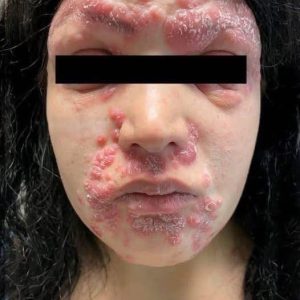Discovering a bump, lesion, or unusual patch on a child’s scalp can be a worrying experience, especially when immediate medical care is not available. While professional evaluation is always the safest approach, understanding common scalp conditions can help parents recognize patterns, manage minor symptoms, and determine when to seek urgent care. Scalp issues can arise from a variety of causes, including genetics, hygiene habits, infections, and environmental factors. Conditions like seborrheic dermatitis often present as greasy, yellowish flakes, whereas folliculitis manifests as small, tender bumps caused by bacterial or fungal infections. Pilar cysts, benign fluid-filled sacs, may also develop, sometimes growing large. Because many scalp disorders appear similar, careful observation is essential to guide appropriate treatment or home care measures.
Psoriasis vulgaris is one of the most common and often misunderstood scalp conditions. It is a chronic autoimmune disorder in which the immune system accelerates skin-cell production, resulting in thick, red plaques topped with silvery scales. Although incurable, psoriasis can be effectively managed with proper care and treatment. Flare-ups are often triggered by stress, infections, cold weather, or certain medications, making awareness of these factors important for long-term management. Scalp psoriasis typically appears as sharply defined patches that may extend beyond the hairline, accompanied by itching, burning, and sometimes temporary hair thinning due to scratching. Distinguishing these plaques from seborrheic dermatitis or other scalp conditions is crucial, as psoriasis plaques are generally thicker and more clearly outlined.
Parents and caregivers can implement several home strategies to alleviate mild symptoms while waiting for professional consultation. Moisturizing with coconut oil or aloe vera helps soften thick scales, and diluted apple cider vinegar may reduce itching because of its natural antiseptic properties. Controlled sunlight exposure, avoiding burns, can also slow the rapid turnover of skin cells characteristic of psoriasis. Over-the-counter treatments offer additional relief: coal tar shampoos can slow skin growth, salicylic acid aids in removing thick plaques, and mild corticosteroid creams or foams can reduce inflammation and itching when used appropriately. Following product instructions carefully and consulting a pharmacist can prevent misuse and ensure the most effective relief for mild to moderate cases.
Knowing when to seek medical attention is critical, as some symptoms indicate a need for urgent evaluation. Parents should consult a doctor if symptoms worsen, do not improve after several weeks, or interfere with daily life and sleep. Signs of infection, including spreading redness, pus, fever, or severe pain, require immediate professional care. Dermatologists can confirm the diagnosis and prescribe treatments tailored to the severity of the condition, such as stronger corticosteroids, medicated foams, or phototherapy. Long-term management at home involves consistency in moisturizing, maintaining a humid environment, gentle hair care, avoiding triggers like harsh products or stress, and tracking symptoms over time. Keeping a detailed diary and taking periodic photographs can help both families and medical providers monitor the condition and adjust treatment as needed.
Finally, some popular home and viral remedies may provide additional relief when used cautiously. Tea tree oil, known for its antifungal and anti-inflammatory properties, can be added sparingly to shampoo, while a baking-soda paste may help gently exfoliate dead skin. Patch-testing any new product is recommended to avoid irritation, and treatments should be discontinued if adverse reactions occur. Clear documentation of the child’s symptoms—including onset, severity, and possible triggers—supports accurate medical evaluation and effective management. By combining awareness, consistent home care, and timely professional consultation, caregivers can help children with scalp psoriasis maintain comfort, reduce flare-ups, and prevent complications, all while fostering a proactive approach to managing this chronic condition.





